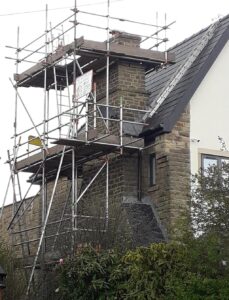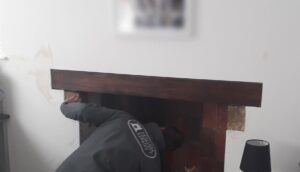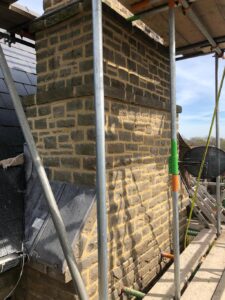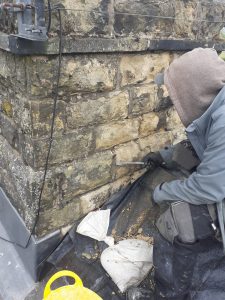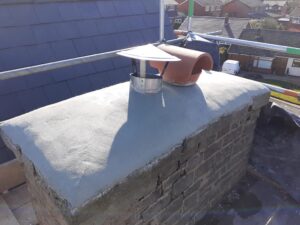As a chimney is high level and protrudes through a roof covering to form a new structure, it can be problematic for water ingress issues. We have as such, undertaken many Chimney overhauls to source and correct damp related issues.
The chimney structure can include: stone or brickwork, mortar, leadwork, pot or flue outlets, flaunching (AKA capping) and sometimes render. We can therefore investigate each aspect to identify sources of water ingress:
Masonry
Masonry includes Stone or brickwork. In an exposed location these can be affected and may require replacement.
If the structural integrity of a chimney is good and solid, then it does not require taking down for a rebuild.
Lime Pointing / Render
One of the key issues that we encounter during Heritage Property Repairs is cementitious mortar. This is non-porous and as such traps moisture. Therefore, the moisture must evaporate through the masonry, eventually causing damage evident by ‘blowing’ (shearing-off) the faces from stone or brickwork.
Cement hardens overtime, damaging the surrounding masonry and cracking. This permits water ingress into the cracks that degrades the structure further and washes any bedding mortar. A Lime mix – undertaken by an experienced Craftsman – is a traditional porous ‘breathable’ product. This permits the passage of moisture without damaging masonry. Its flexibility is also suited for heritage properties which are not necessarily rigid structures, unlike modern houses design.
Where we find that mortar is cementitous and/or overpointed. We will rake out the joints, and repoint the chimney at the high level stack and face elevations with a lime mortar mix.
Lead Work
If over 60 years old, or not undertaken by a skilled experience lead specialist, leadwork may not be preventing water ingress at abutments and joints. Poorly detailed, unwelded lead in the incorrect Code is what we commonly find and correct.
The coding of lead refers to the category of the thickness of the material. Detailing guidelines are set out by the Lead Sheet Association who are the authority on leadwork and are now known as The Lead Sheet Training Academy.
A chimney lead can be made up of a back-gutter, apron, flashing and soakers. The new lead must be coated in patination in order to protect from carbonation.
Chimney Pots/Outlets
Over time chimney pots may become brittle or may crack from pressure. Some are left uncovered so we would advise cowls to be carefully and suitably fitted.
Where chimneys have been capped and blocked, these can still trap moisture from hot air that rises or the . We would ensure that the flues are correctly ventilated.
Flaunching
The flaunching (or capping) to the Chimney top is commonly now incorrectly formed in a cement and general sand mix. This typically fails by cracking and breaking up. We reflaunch with a Lime mix which offers the flexibility to avoid the disadvantages of using cement.

